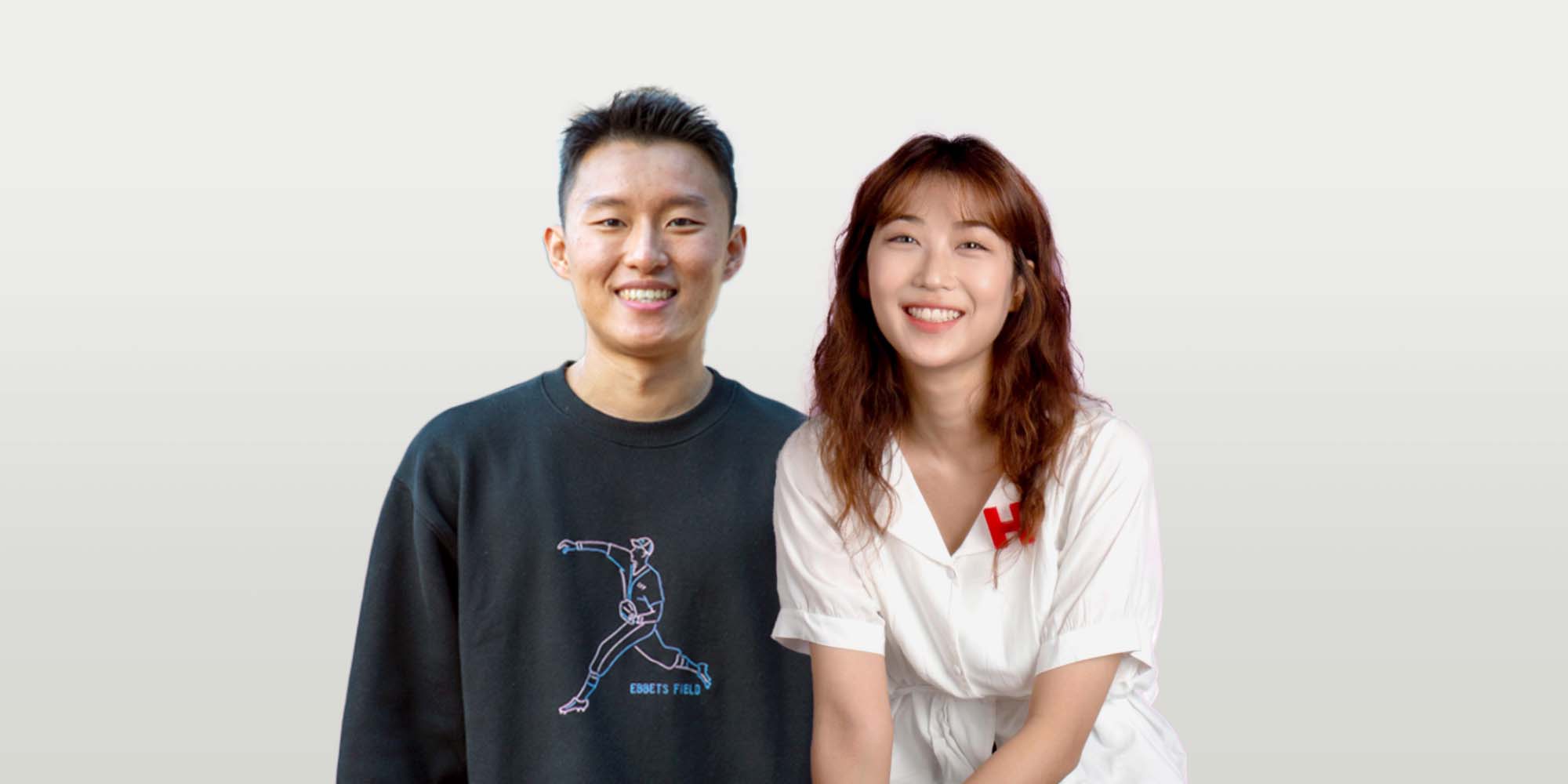
Life in UNIST Design: Stories from Two Fresh Masters
Interviewed by Hyori LeeYou can find the Korean version of this page here.
이 페이지의 한국어 버전은 여기에서 찾을 수 있습니다.
On a hot summer night in 2021, I met two alumni who recently completed their master’s degrees from UNIST Design – Sungwon and Hyo-jeong. Inviting these two for the Zoom interview, I expected our discussion to cover a wide range of topics because Sungwon and Hyo-jeong must have experienced UNIST Design differently while also sharing many commonalities.
Sungwon began his days at UNIST seven years back after his undergraduate time and had been a master’s student at New Design Studio (NDS) studying to become a service designer. Hyo-jeong spent only two years at UNIST as a master’s student at OF NOW Lab (OND) to become a UX designer. That said, the two labs often collaborate thanks to their disciplinary affinity, and Sungwon and Hyo-jeong both did their thesis projects focusing on the well-being of social minorities. The interview turned out to be a meaningful one that surpassed my initial expectations and we shared concerns and insights into our field – which I am sure will be useful for future UNIST Design students and the like.
Interviewee One: Sungwon Jang
- Lab New Design Studio
- Thesis project Beyond Mere Listening: A User Experience Record Manual to Improve Accessibility of Public Mobile Applications for the Visually Impaired
- Current job COO at a digital healthcare platform start-up
Interviewee Two: Hyo-jeong Jin
- Lab OF NOW Lab
- Thesis project ECHO: Digital Service Platform for Diabetes Management in Young Patients
- Current job Junior Product Manager at Likelion
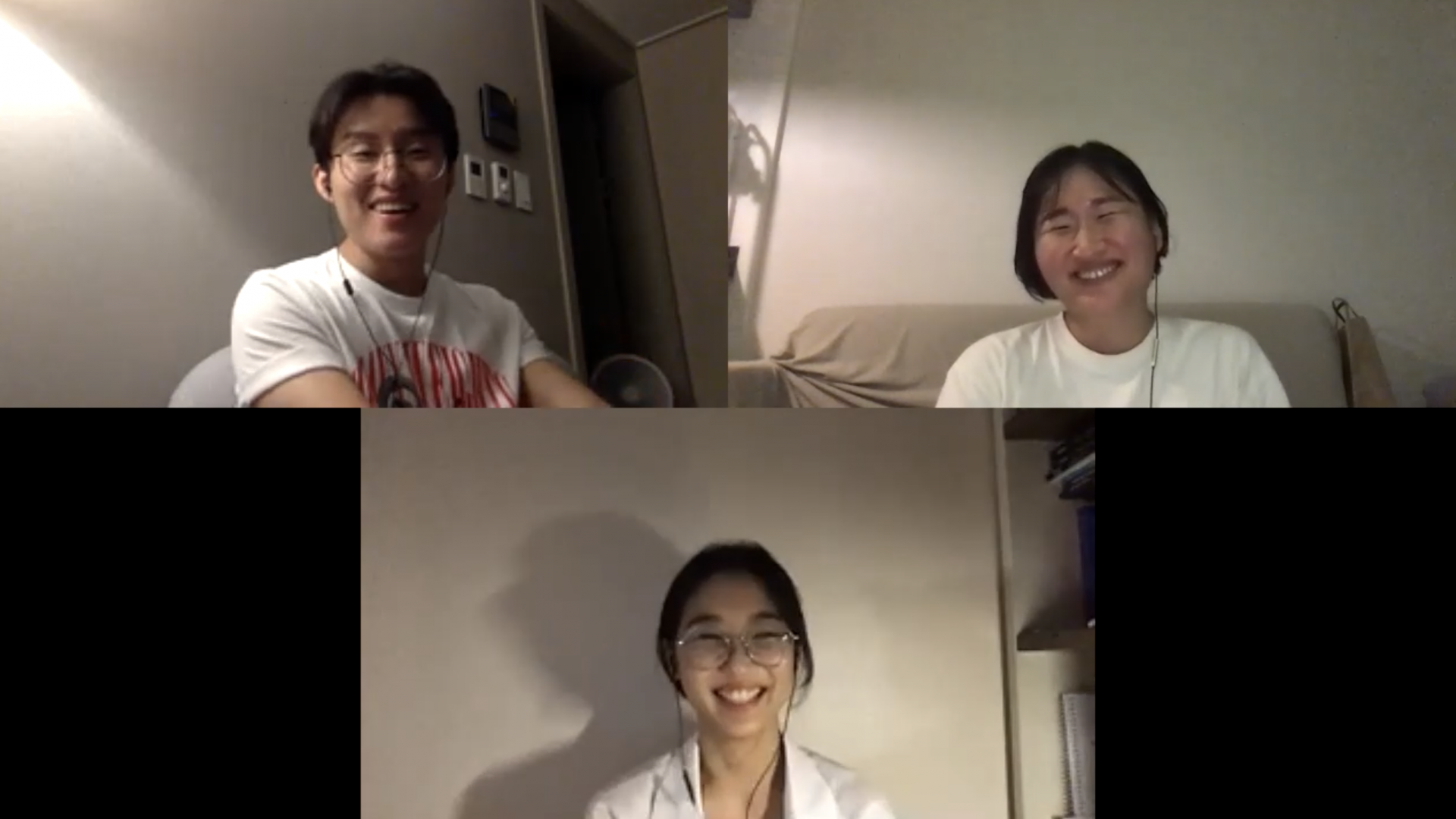
Hyori Lee (HR) How was your experience in respective labs for the past two years?
Sungwon Jang (SW) Thinking of my days in New Design Studio (NDS), it comes first to my mind that I enjoyed a good work-life balance. Meanwhile, it was also the time to figure out which skills and knowledge I should sharpen more. Also, all the members were friendly to each other, while professionally working on projects. Now I’m working for a company and it’s all about money, and it sometimes reminds me of myself back then, as well as how simple my life was in the lab.
Hyo-jeong Jin (HJ) To me, the most memorable time was when I and other colleagues in OF NOW Lab (ONL) thought and debated about the projects. Also, I could spend much time alone thinking about things around me – like juggling (managing) between different tasks within the limited time I had. The way I arranged my schedule made a small difference for the next day, and little by little as time went by, everything could improve. I could not help but ask questions to myself like a teenage girl, “Am I not wasting my time?” or “Was it a good choice for my project?” during the whole time in my master’s study. In short, my days in UNIST were filled with discussions both with my teammates about the project in the lab and with myself about whether I am spending my time effectively and efficiently.
SW I am becoming increasingly aware of how the school and my lab were really safe places for me. Back then, I sometimes felt the urge to reject the advice from the professors because I thought they were meddling. Now, as the only designer in the company, I recognize how much I was protected by the professors, like a strong fence protecting me. I heavily relied on Prof. Seungho Park-Lee and Prof. Hwang Kim at that time. Now I have no one but myself whenever I have to make decisions, needless to say that I am the only one that is responsible for design outcomes. The pressure became way heavier now. I was lucky that I was able to do things with their help and support.
HR Is there anything you do today that you took inspiration from the ways Park-Lee or Kim made decisions?
SW Yes. As a designer, I am trying to build a culture and system in our company, which is not always easy. At that moment, I feel grateful and sorry for my professors for what they have done for me.
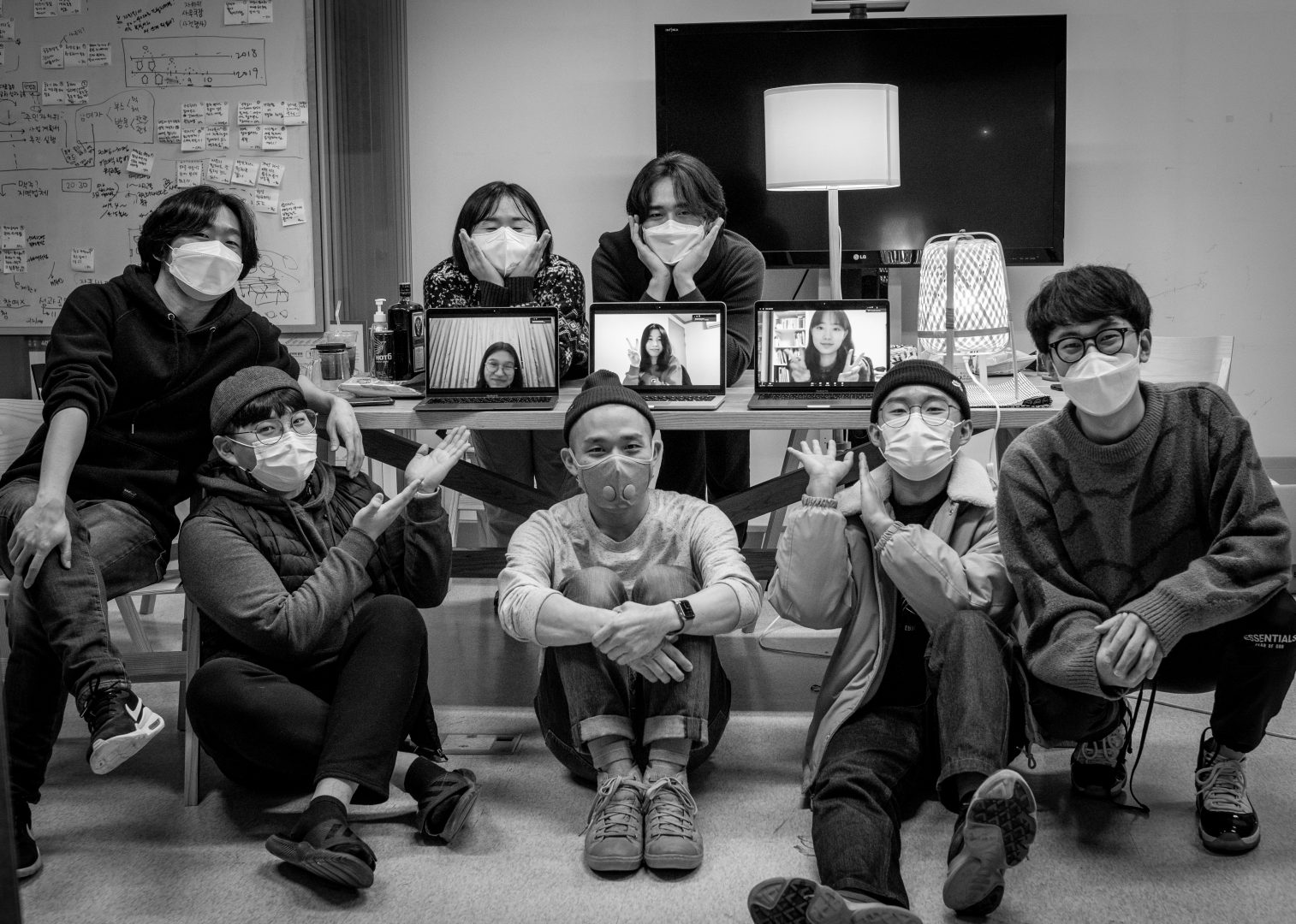
HR What would you say the differentiation point of the labs you had been a part of?
SW Among all the labs, I feel, the professor and the members of NDS were the most committed to building rules and culture of the lab, where everyone participated actively and voluntarily to make guidelines for spending time in the lab. Given the nature of guidelines as rules, sometimes it may feel uncomfortable, but even such discomfort can be mitigated by continued discussion. In doing so, I got excited by the process of building, operating, and further developing the rules and culture.
HJ My lab, OF NOW, was like a library or community center in the user experience (UX) field. Above all, there are lots of reference materials in the lab, which we can read, watch, and discuss at any time. Sometimes we watch a reference video on TV talking about it while having lunch or dinner. That way, we could deepen our understanding of our fields daily with so much fun. We have that vibe of sharing and enjoying anything UX with one another.
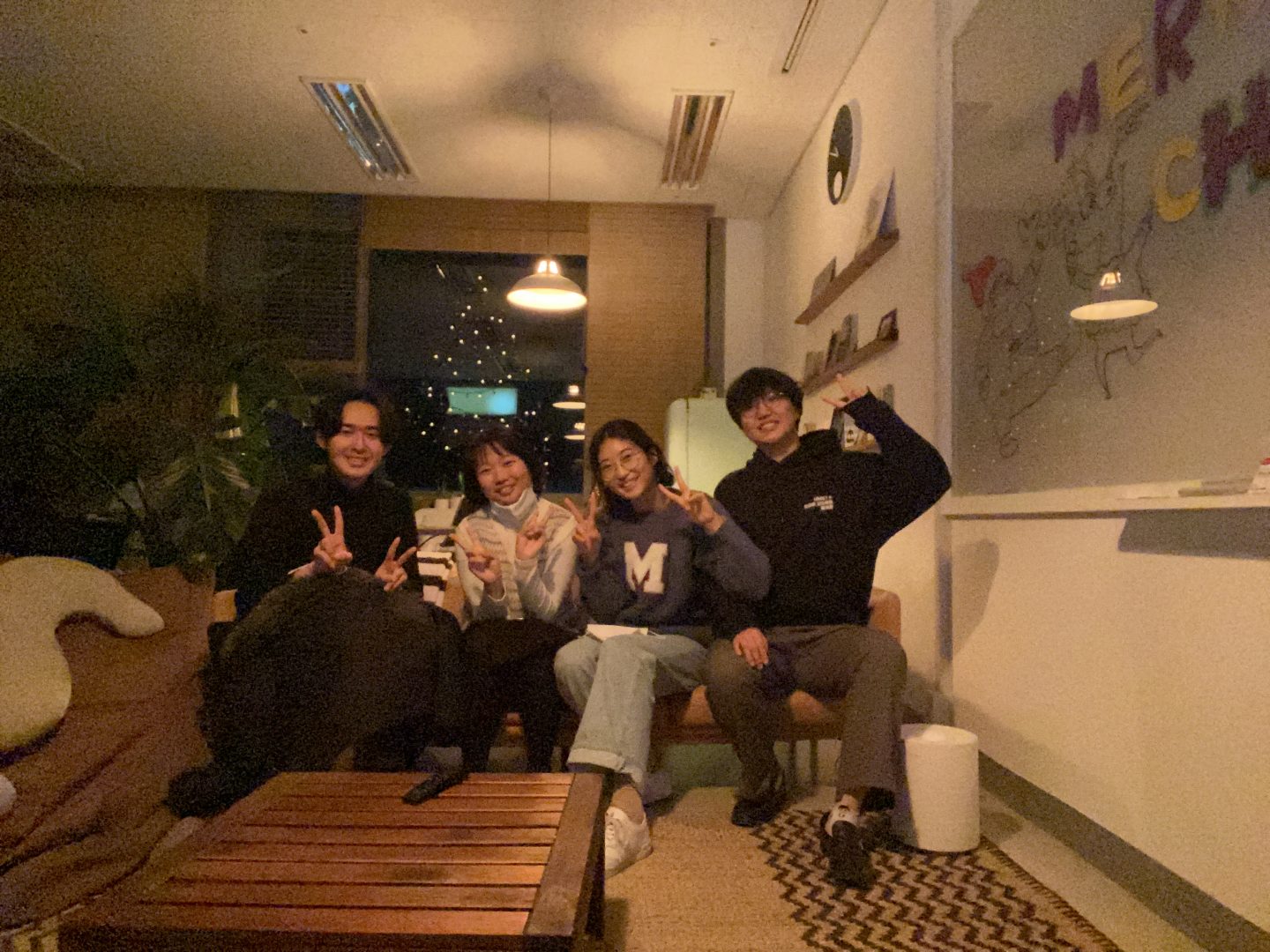

HR As somebody who graduated from another university, I strongly feel that the students studying design here have a craving for studying design. They pursue design so passionately, even outside their courses.
HJ I feel the same as a person who did a bachelor’s study elsewhere. Everyone here loves design so much. I literally learned their passion for design from my friends here.
SW All the students in the Design Department of UNIST love design so much because, without such sincerity, most of us wouldn’t have majored in design – graduating a high school with a strong interest in science and engineering, studying basic science as a freshman, to making a decision to major design and continuing on it in the graduate school in an institute of science and technology. Still, most students are inclined to think they are never ready to work with something aesthetic and visual, pushing themselves harder and harder for better outcomes. So in a sense, everyone in the NDS and Of Now lab naturally looks deeper into the users. To feel the same way with them, we try to look at them as deep as possible, sometimes a little too much perhaps.
HR You remind me of an intern who recently came from another university to the NDS for a summer internship. At first, the student could hardly understand our qualitative method, then he said his mind had been changed by the end of the summer.
SW In my company, I had a hard time sitting down with my colleagues and convincing them that, ‘we need to do in-depth interviews because our services lack this kind of insight’. My colleagues did not want to do that saying, ‘it takes too long’, ‘we can’t do it because of COVID-19’, or ‘we need profit now, not interviews’. But now, I enjoy persuading them and sometimes they tell me we need such interviews.
HJ I think that depends on a designer’s capability. As a designer, we should be able to say that our product or service will be better through this or that process.
HR I cannot agree more with you two. Then, can you describe your lab in a few words?
HJ For ONL, “UX, we nailed it.”
SW For NDS, “Liberty and Discipline.”
HR Cool! Is there anything you want to talk about UNIST?
SW I’d like to mention its location. Working in Seoul, I find myself lucky that I had a chance to study design in Ulsan, instead of Seoul. Without UNIST, I could never have experienced and understood the characteristics of the region, its people, and the culture, surrounded by urban-rural complex areas.
Here is an example. I participated in a project where we tried to understand the mobility needs of disadvantaged people in Ulsan, and it taught me that such environmental differences do exist. The contexts and the resulting behaviors I observed in Ulsan hardly repeat themselves in Seoul. In Ulsan, the tight bus schedule prompts bus drivers to skip bus stops or exceed the speed limit. In Seoul, buses usually keep on schedule, and passengers wait to get off until the driver pulls over. I realized from this that each city has its regional and environmental factors to consider. And that’s why I feel lucky to have experience in both cities because they are examples of extremely different environments to me, having myself more prepared for any unexpected situation.
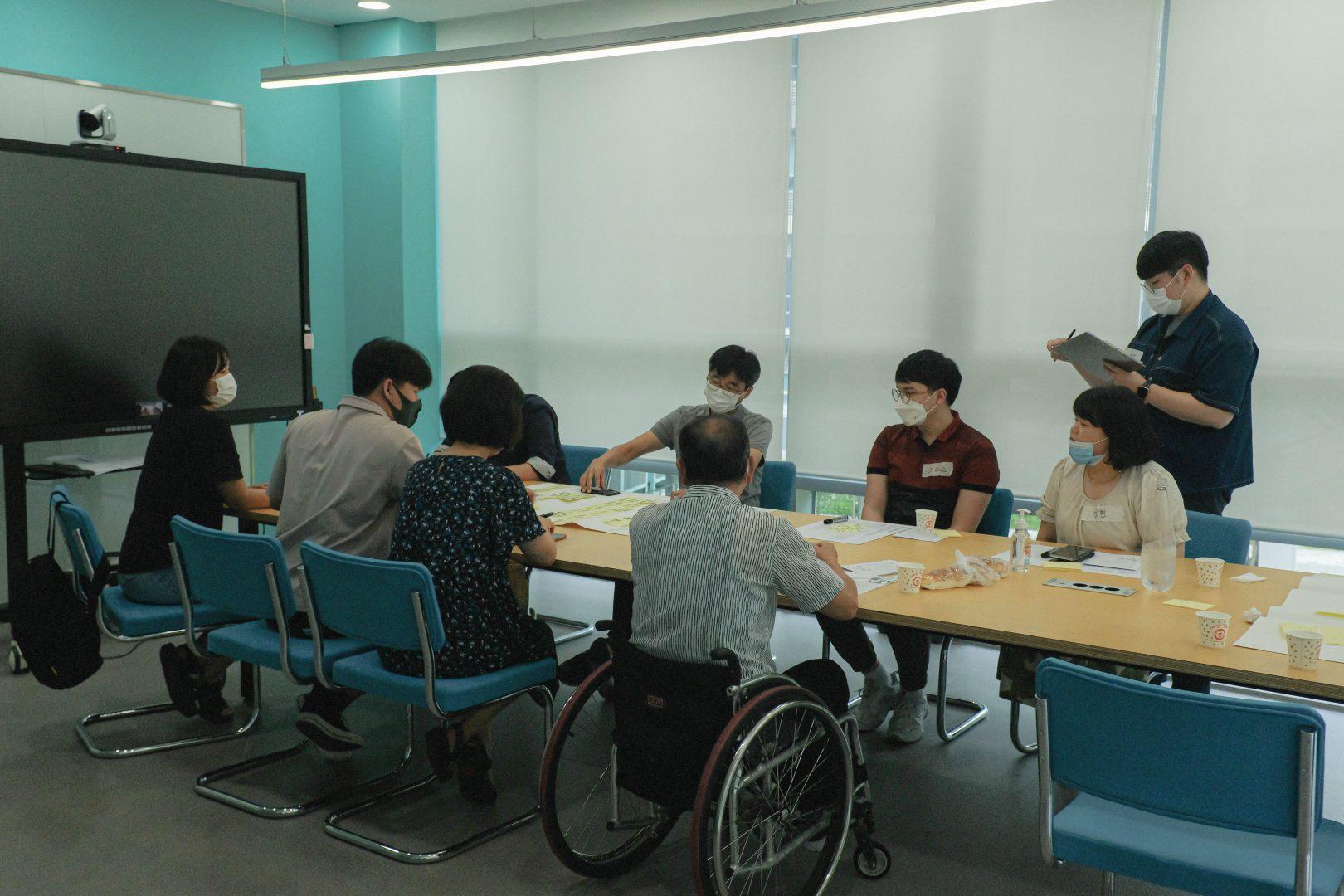
HJ When I think about UNIST, I think about the professors first. Before joining UNIST, I had a busy life looking for good materials to do better. However, in graduate school, I never had enough time only to digest the materials provided inside the community. The professors are all working actively in the field and they are doing their best for research activities. They used their network and invited renowned speakers for seminars almost every week during the semesters. It’s not so easy to meet and listen to this level of speakers outside UNIST. As a student, I was spoiled in such a great environment around the professors who led me into various and priceless experiences. I am honored to have learned from them as a student, and an individual, too. They never hesitated to give me feedback whenever I went to ask them questions. They were like a vault with heaps of design ideas to me.
SW As a matter of fact, the students in UNIST tend to forget how well-equipped this university is in terms of its infrastructure because they are so accustomed to it. Right now, my office is in a bad location and has problems with air-conditioning. So, it is definitely not like those days when Prof. Seungho Park-Lee furnished the lab space with ergonomic desks and chairs for students and when Prof. Hwang Kim got us expensive cameras for video making. Aside from that, the overall infrastructure of the university itself is simply outstanding. I sometimes regret that I didn’t utilize them more.
HR I think UNIST is showing its eagerness to become a better institution by scouting young professors from new fields.
SW I agree. I guess people in UNIST are young and open to creating new traditions. In doing so, we might sometimes see some outdated, top-down conventions as if they are traditions. But when someone claims that s/he feels uncomfortable with such things, our professors immediately discuss improving or abolishing them if they do not seem right. More than that, such a decision gets implemented so fast, sometimes surprising us.
HR Well then, what will be your phrase to describe UNIST?
SW “The new tradition.”
HJ “Wakanda in Ulsan! You don’t know it from outside, so come and behold it! We live in the 23rd Century here!”
HR All right. Now, let’s talk about your graduation projects. First, please introduce yours to me briefly.
HJ Okay. Mine was a mobile app service for younger diabetic patients. It originally began from a project in one of the classes I attended, but I wanted to develop it after the class, and finally took it for my master’s graduation project.
SW In my project, I tried to figure out solutions to make the public mobile applications more accessible for the visually impaired.
HR What made you choose such a subject for your project?
HJ When I was doing my bachelor’s, I had UX project for diabetic patients. The solution to the service was proposed by linking a diabetes blood glucose meter with mobile app based on IOT technology. Looking back on the project at the time, I realized that we need to help diabetic patients to be able to manage their daily lives instead of just simply linking blood glucose. While starting my personal project in my master’s degree I remembered the time and the work I had during my bachelor’s class. I tried to help diabetic patients to manage their daily lives through a more in-depth user experience study and research. In that sense, young diabetic patients were quite a target to focus on. Because, in the past five years, the rate of increase or decrease in young diabetic patients in their 20s and 30s has been increasing very rapidly, reaching 30% and there was a realistic expectation that they could provide more active interactions and functions to those who were familiar with mobile.
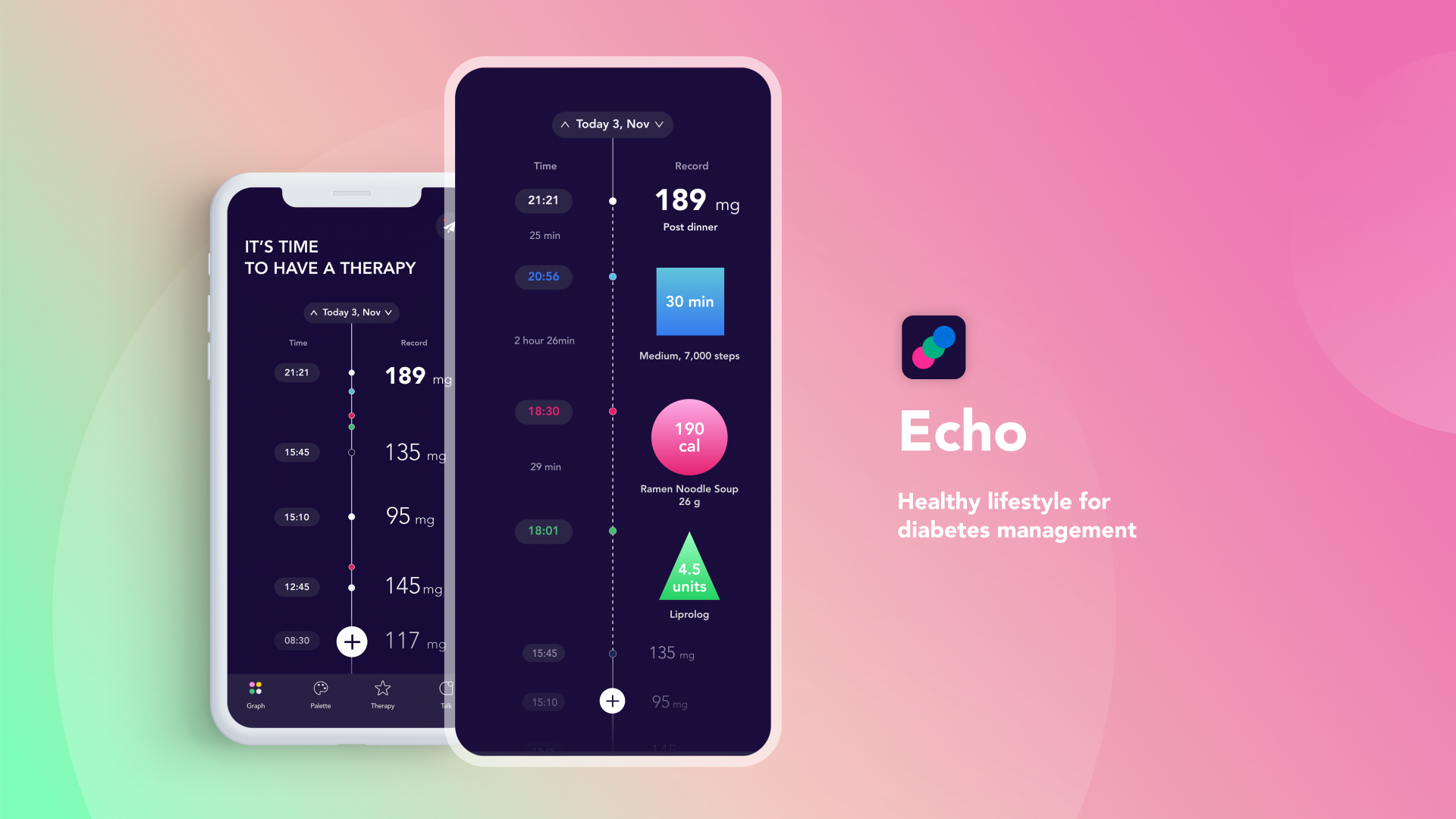
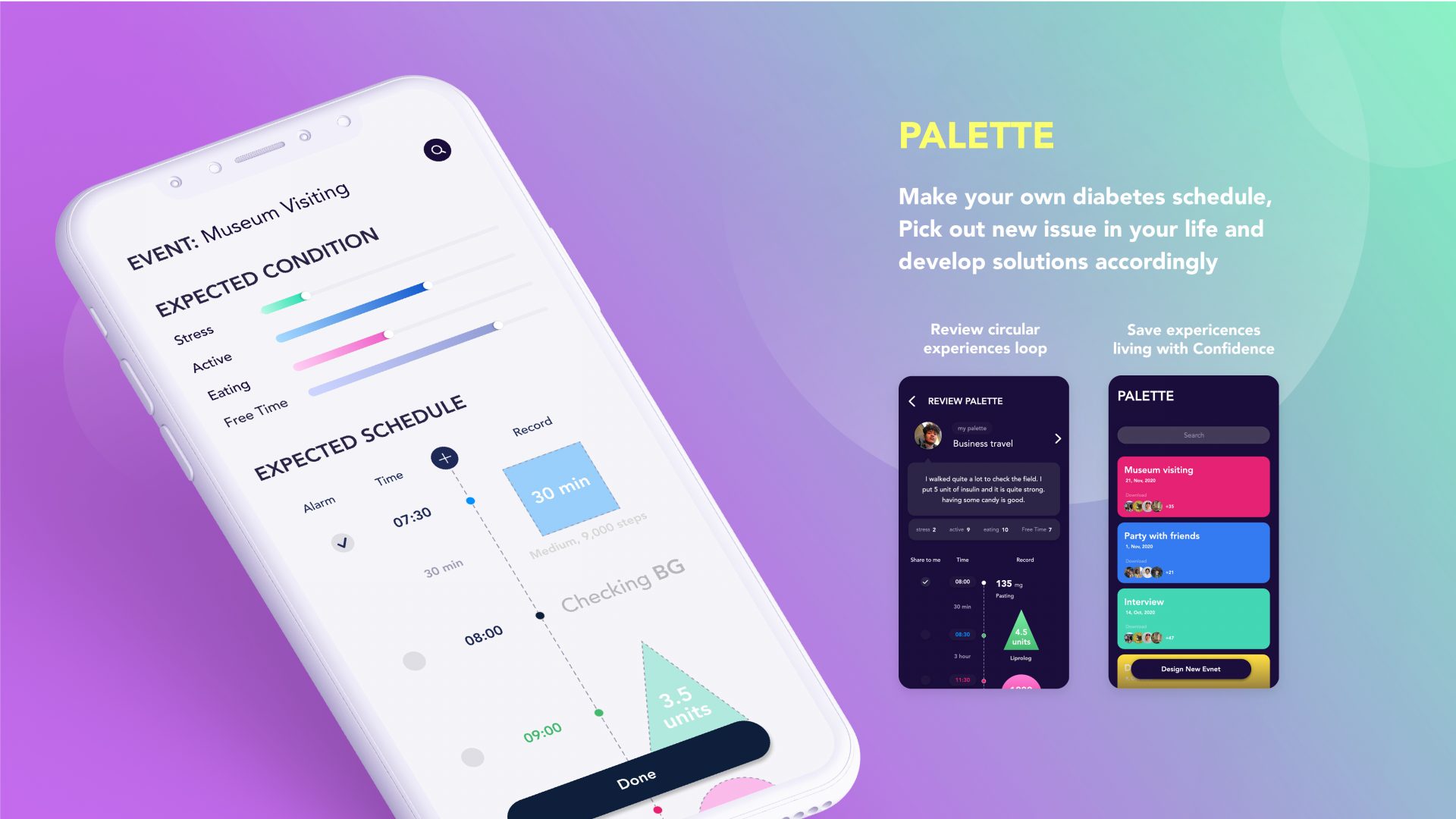
HR When I first heard that your project was about “young” diabetic patients, I found it very interesting, especially how you strategically targeted your subjects. Generally speaking, we tend to think that diabetic patients are middle-aged or above. Your subject of choice seems really valuable because the younger patients seem to be outside the mainstream discussion about the challenges.
HJ Right. While I was doing research about them, I was able to find problems that arise because they were “young” diabetics. The patient’s “loss of self-esteem” was very evident due to various social spectrums and stereotypes on young diabetic patients. In addition, mental illnesses such as “tiredness” and “depression” about diabetes management itself, which were constantly required, emerged. As the definition of the problem became clear, the research-based solution from the UX perspective was able to emerge. Finally, it was possible to hypothesize and verify through user tests by presenting mobile interactive elements and data-based functions.
SW Mine was from a mobility research project for the minorities that the NDS conducted two years ago. At that time, we invited people with various types of disabilities for a co-design workshop, and I was assigned to help one participant with an acquired visual impairment. By helping her, I learned the functional limitations of assistive technologies, like Burmi Call, the taxi service for people with disabilities in Ulsan, and the voice-over tool of the smartphone. It was a reality check for me after seeing that even the government service – not a private one – failed to help out everyone. So I tried to see a bigger picture from the point of view as a service designer, like why such principles are not adhered to, who and what we should focus on from the entire system, and what type of connections should be made, etc. I figured that the most effective way, for the time being, is to inform the customer service center staff of the informational accessibility with the manual.
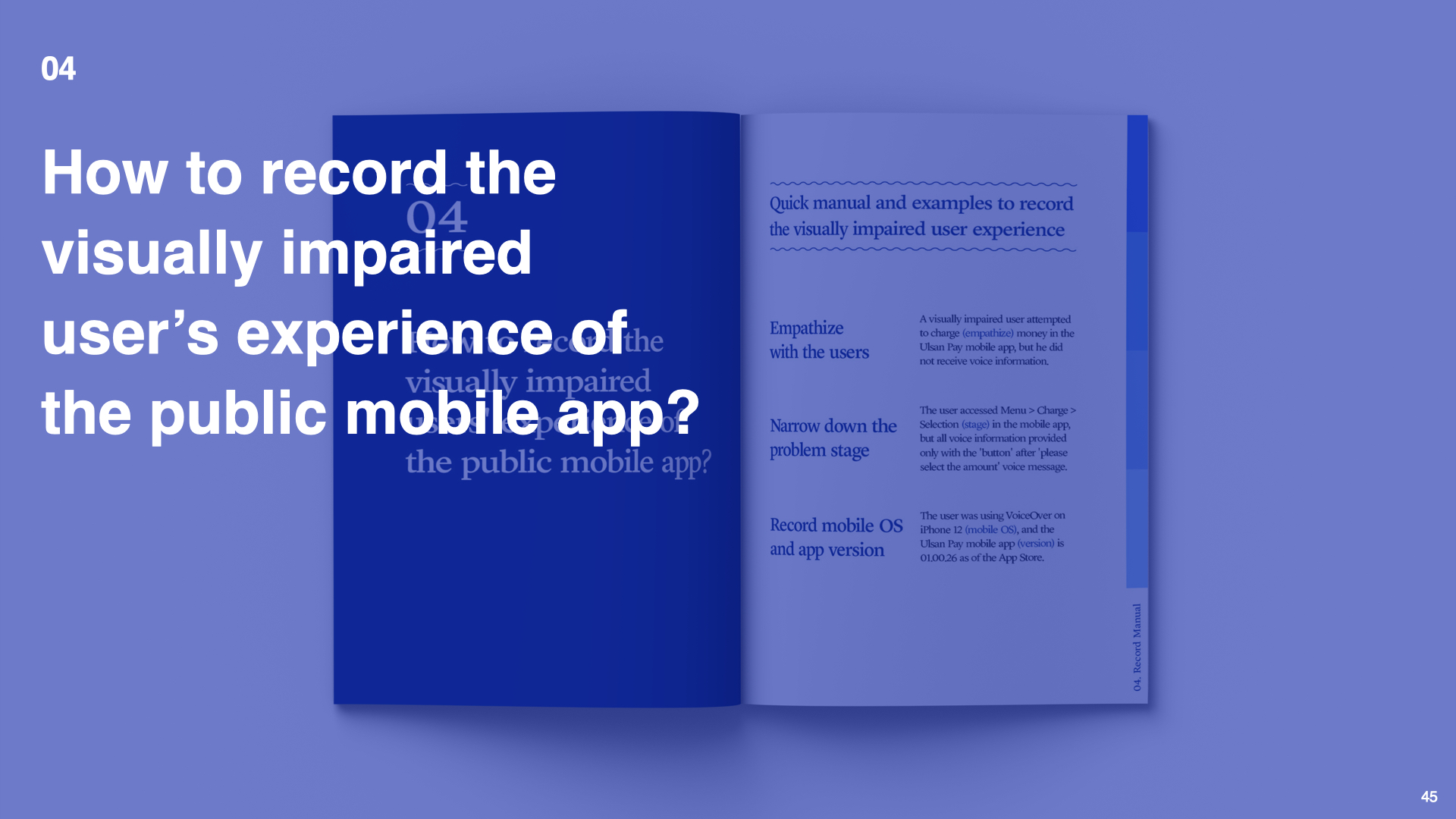
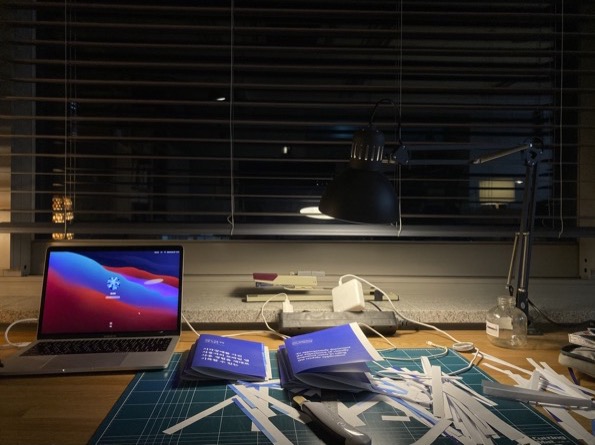

HR How was your graduation process? We all know how meticulous the process in the design department of UNIST can be.
HJ It was definitely not easy but also was enjoyable. As to the graduation project, all of the students at UNIST choose the subject with deliberation. I also chose mine free of the influences of professors or other people. That’s how I was able to fully enjoy concentrating on the subject with much depth, no matter how difficult it was.
SW UNIST Design is building its own tradition even with the graduation process. Among the students at UNIST, others hardly know about our own procedure, such as the Green Light, where professors take time to read your thesis much earlier than the deadline and give advice to help you. Recently the thesis defense has been made to be a public event. This unique culture was born from everyone in the department, the professors and the students respecting and caring for each other. Each step was difficult to advance, but in the end, I felt so proud and relieved that I had such an experience. Without the Green Light, the preparation for my defense would have been really painful. Likewise, if it were not done openly, much fewer people would have seen how hard I had studied for the previous two years. All these things are the results of mutual respect between professors and students. And it is continually developing, even today.
HJ Totally agree. It is true that the process can feel very tricky at times, but it is not to nitpick on our work. When the time comes for you in the process, you will eventually realize that every step is meant for synergy among us and a better outcome for everyone. The Special Topics course by Prof. Hui-Sung Lee also was very helpful for me during the final semester. Initially, I questioned if I should take an extra course about graduation itself, but lots of good feedback from the sessions turned out to be a firm foundation for my successful graduation. The graduation process of the UNIST design department truly makes students grow. Simply best.
SW I heard the system was not like this for the alumni who graduated three or four years ago. There were trials and errors. So I can’t help expecting how better it will be in the future.
HR Well, then. What was the most significant personal gain for you from your graduation process?
SW One thing that comes to my mind – becoming independent. Other projects were all led by the professors and we students followed. However, this is not the case anymore for my graduation project. The professor stood aside watching how I manage the project. As the advisor, the professor gave me a hint only when I was going too far in the wrong direction. So, there were times I felt anxious or stressed inevitably, and sometimes it was tough enough to make me blame him. Then, when my project passed a turning point, I realized that I learned from the process itself that made me a more confident person.
HJ What I learned the most was the attitude I am supposed to have about my project as a designer. My project was already finished once during a course, so it was my choice whether I go further with it or not. I pushed myself and developed it further because I was getting ambitious as a designer. In doing so, I figured out that there is no such thing as a fixed finish line in design. The deeper I go through, the better things get. Whenever I make a hypothesis and try that, it becomes a whole different experience for users. So, I had fun. I told myself, “I thought it was over, but I was wrong. I found more possibilities from the trials!” I don’t think I will ever have such time again, wherein I spend hours, days, weeks, and months on end trying to keep developing a project further and further.
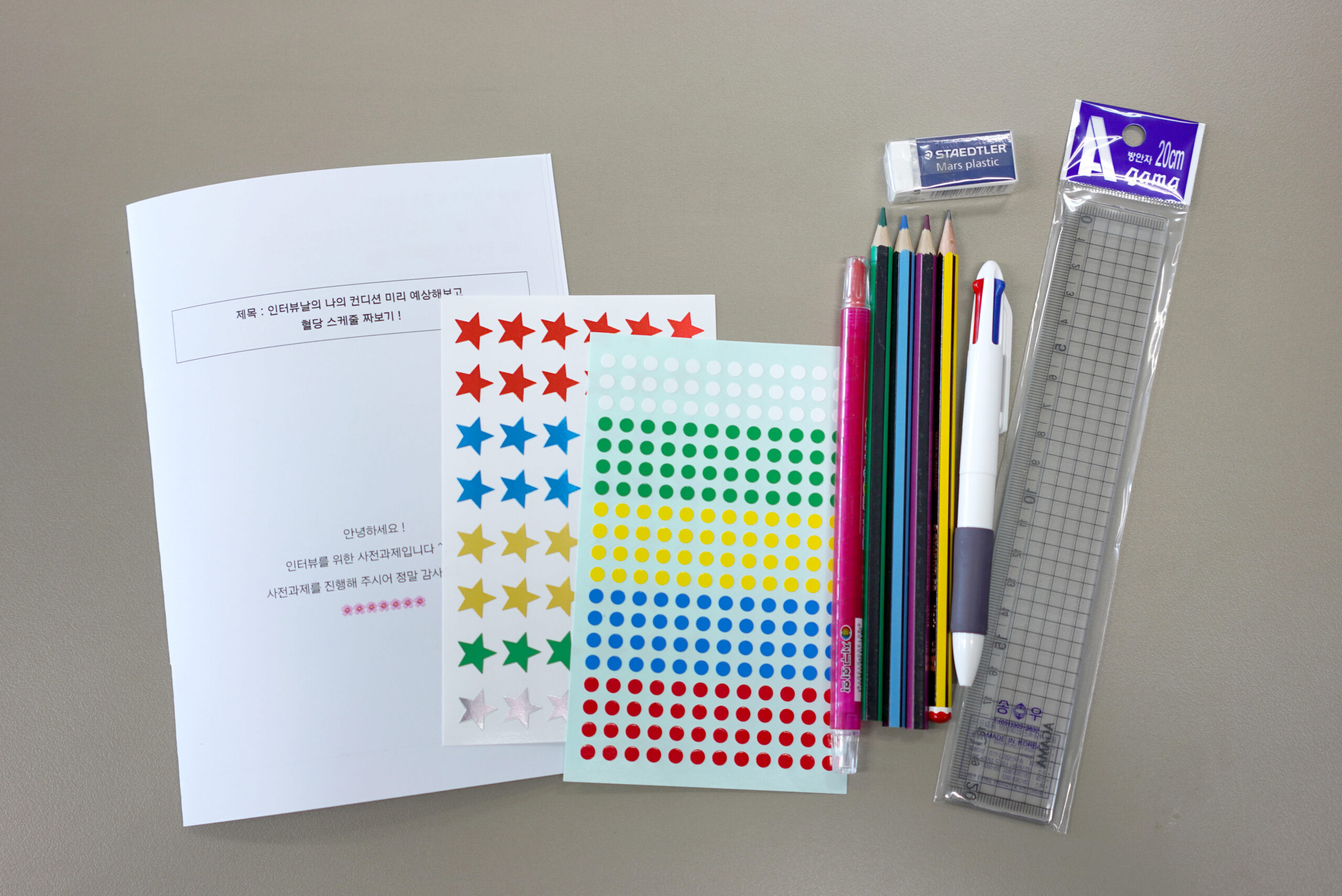

SW I totally agree with what HJ just said. Although I still want feedback from every individual user, I cannot do that while working on a commercial service, monitoring thousands of users. I don’t have time to meet each user asking questions and talking about the service as I did at UNIST. Maybe that is why I cherish my time in UNIST Design and feel proud of them.
On the other hand, it was not always so glorious to look into users’ experiences deeply. To be honest, some of them may have been the most frustrating and painful moments in my whole life. As I mentioned earlier, I got a chance to see what it is like to be visually impaired. Looking into their lives closer, I doubted myself if I was right about them and kept coming up with wrong ideas. All these were very painful. Despite the time of affliction, I could manage to stand on my own feet at last. That made those days more precious to me.
HR I appreciate your earnest answers. Changing the subject, what do you want to tell the UNIST students like me or those who wish to enter UNIST, as someone who just finished the journey?
SW I have one thing to tell my fellows who studied and got bachelor’s degrees from UNIST. Be more confident. Those who graduated from UNIST Design – whether bachelors or masters – seem to be a bit worried about their skills and capabilities. Even if they are really good, they tend to think that, ‘I am not enough, I should do better’. Of course, this can be a fuel for self-improvement, but it can equally be self-defeating. I was the same, but once I leave UNIST and start working, I realize that I am good enough, and I can do stuff. No need to be discouraged. You will feel, ‘Oh, I am quite good, I am doing well, and I can use what I’ve learnt!’. So, be confident!
HR I feel the same. From the point of view of someone who graduated from another university, I felt the students here tend to be harsh on themselves. Sometimes too harsh.
HJ I agree. Everyone does everything very hard, but no one is generous to herself/himself. I told the same thing to SW all the time. I hope they realize how good they really are.
SW As the one who went through undergraduate and graduate schools in UNIST, I think it is because we didn’t have enough chances to prove ourselves. UNIST is in Ulsan, far from Seoul, and the design department is one of the smallest departments in UNIST. The lack of chances for the student to see their competence objectively may make us think that we are not enough. Listening to the students who worked as interns or took a semester off and were on leave to work as designers, they all say the students here are really capable. Perhaps more chances for such experience will mitigate such insecurity bit by bit.
HR Recently, Ha-yeon, who graduated only a few years ago, visited the campus for a seminar. She made me think of you two, how you would be like her – visiting UNIST in the near future. That made me smile.
SW Yeah. That is one of my motivations that makes me work hard today. I don’t want to make myself a shameful example of UNIST alumni. I want to make an outstanding achievement and become a good example as she and others did.
HJ I just realized that she also did her bachelor’s study at another university before joining UNIST for her master’s study.
HR True! Now, what are your plans for the future?
HJ I will continue doing UX design. The more I learn and work on it, the more I enjoy it. Although I said there are so many things to discover inside UNIST, I can also recommend you to keep an eye on what is happening outside UNIST. There you can get new insights from UX field, which will keep you excited about your work. Recently I read an article that talk about how UX designers had never intended to make users smombies (smartphone zombies), but that nevertheless happened. I think that UX designers should be aware of this kind of problem, too. As UX designers dealing with user experience, we need to keep studying and researching.
SW I strive to widen my perspective. Getting out of the world full of designers and working with developers and managers, I realize how fun and meaningful it is to design a service logic considering the entirety of complex problems together. Before, I focused on users only, which now I realized may result in a bad experience for users. We should consider the views of marketers, developers, CEO, and others involved in the service, or a project might become very different from what it was supposed to be. Each stakeholder has the reason for his/her opinions and ideas about a project, and I need to do more to understand them. When I will be able to fully understand them, that will be the moment I will be ready to create my own content with an ideal worldview.
HJ What SW just mentioned is very interesting. Lately, I have thought a lot about the difference between UX and service design. From the way I see it, service design is looking over the overall service, understanding its connection to the users at each point, setting the flow and the balance of the service, and establishing rules as desired. On the other hand, UX design is to research how we can apply our objectives and hypotheses to the product/service in users’ shoes. Like the term “lean UX,” setting up a hypothesis and testing it quickly is the essence of it. I think what we just talked about helped make the difference clearer.
HR Speaking in development terms, it’s like the backend and frontend.
HJ Exactly, that’s how people describe them.
SW I would be very happy to have both UX designers who look into users and touchpoints and service designers who see beyond in my company. I think small companies especially need them. Otherwise, a service or a product will only follow the opinion of the loudest voice, so to speak. I think only service designers and UX designers can prevent this from happening. To guide a project for the desired outcome, there should be designers with the right mindset.
I thought about this today. One of my company’s services is related to onsite tutoring, but we forget to ask so many important questions because we are doing things in a hurry all the time. Basic questions such as the following are easy to ask: “Under the COVID-19 situation, how can teachers assure parents of safety?”, “Can a mask be the solution?”, “How can we hand masks to the teachers?”, “How can we determine the cost of masks?” etc. However, more difficult, yet important questions like “How would customers feel about it?” or “What are the teachers doing about it?” are seldom asked even though some quick interviews could get us the answers. But without the right mindset, it’s hard to come up with ideas and put them into practice. Experiencing these, I feel that I majored in the right field.
HJ I also am grateful that I have studied and been working in this field. As I said, there are always more things to enjoy.
SW I hope someday people realize the true potential and value of our field. One of my colleagues proposed that I become a partner of the company telling me that he would consider me as a surgeon in an operating room. He told me that the logic he made was messy, and he wanted me to fix it as a concept designer and service designer.
HR I think it would be great if we have time to talk like this regularly.
HJ Since the graduates of UNIST are all playing crucial roles in their positions, I believe this kind of conversation can be so helpful for them if there is an active community.
HR There were so many things to share and learn from each other, although it has been only weeks since you two graduated from UNIST. Thank you so much for your time!
SW+HJ The pleasure was ours. Thanks!